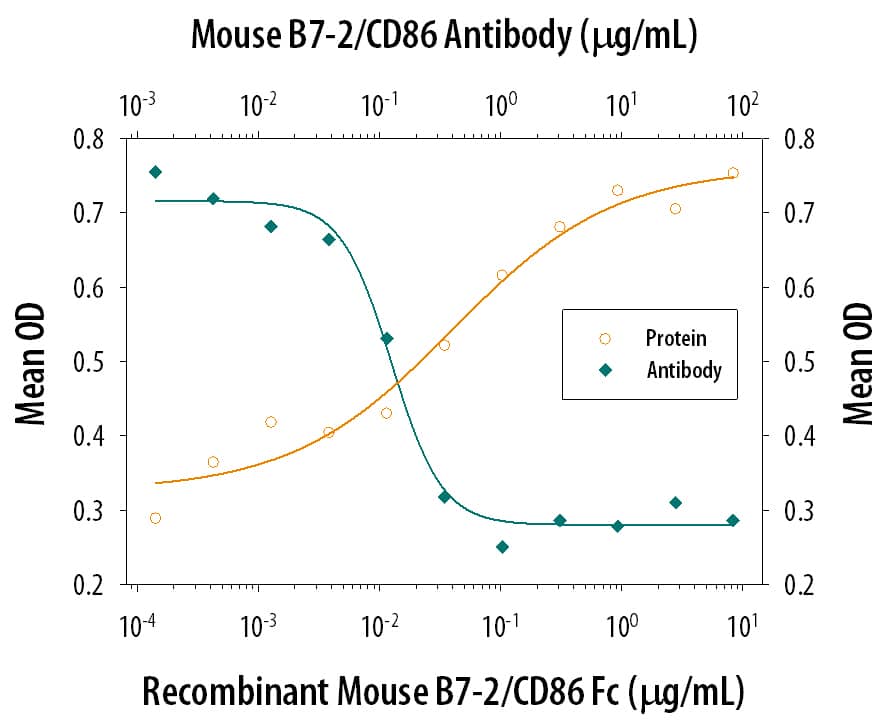Mouse B7-2/CD86 Antibody
R&D Systems, part of Bio-Techne | Catalog # MAB741


Key Product Details
Species Reactivity
Validated:
Cited:
Applications
Validated:
Cited:
Label
Antibody Source
Product Specifications
Immunogen
Specificity
Clonality
Host
Isotype
Endotoxin Level
Scientific Data Images for Mouse B7-2/CD86 Antibody
IL‑2 secretion Induced by B7‑2/CD86 and Neutralization by Mouse B7‑2/CD86 Antibody.
Recombinant Mouse B7-2/CD86 Fc Chimera (Catalog # 741-B2) co-stimulates IL-2 secretion in the Jurkat human acute T cell leukemia cell line in the presence of PHA in a dose-dependent manner (orange line), as measured by the Human IL-2 Quantikine ELISA Kit (Catalog # D2050). IL-2 secretion elicited by Recombinant Mouse B7-2/CD86 Fc Chimera (0.5 µg/mL) and PHA (10 µg/mL) is neutralized (green line) by increasing concentrations of Rat Anti-Mouse B7-2/CD86 Monoclonal Antibody (Catalog # MAB741). The ND50 is typically 0.05-0.25 µg/mL.Applications for Mouse B7-2/CD86 Antibody
CyTOF-ready
Flow Cytometry
Sample: Mouse splenocytes
Western Blot
Sample: Recombinant Mouse B7-2/CD86 Fc Chimera (Catalog # 741-B2)
Neutralization
Formulation, Preparation, and Storage
Purification
Reconstitution
Formulation
Shipping
Stability & Storage
- 12 months from date of receipt, -20 to -70 °C as supplied.
- 1 month, 2 to 8 °C under sterile conditions after reconstitution.
- 6 months, -20 to -70 °C under sterile conditions after reconstitution.
Background: B7-2/CD86
B7-1 and B7-2, together with their receptors CD28 and CTLA-4, constitute one of the dominant costimulatory pathways that regulate T- and B-cell responses. Although both CTLA-4 and CD28 can bind to the same ligands, CTLA-4 binds to B7-1 and B7-2 with a 20‑100 fold higher affinity than CD28 and is involved in the down‑regulation of the immune response. B7-1 is expressed on activated B cells, activated T cells, and macrophages. B7-2 is constitutively expressed on interdigitating dendritic cells, Langerhans cells, peripheral blood dendritic cells, memory B cells, and germinal center B cells. Additionally, B7-2 is expressed at low levels on monocytes and can be up‑regulated through interferon gamma. B7-1 and B7-2 are both members of the immunoglobulin superfamily. Mouse B7-2 is a 309 amino acid (aa) protein containing a putative 23 aa signal peptide, a 221 aa extracellular domain, a 21 aa transmembrane domain, and a 44 aa cytoplasmic domain. Mouse B7-2 and B7-1 share 28% amino acid identity. Mouse and human B7-2 share 50% amino acid identity. However, it has been observed that both human and mouse B7‑1 and B7‑2 can bind to either human or mouse CD28 and CTLA-4, suggesting that there are conserved amino acids which form the B7-1/B7-2/CD28/CTLA-4 critical binding sites.
References
- Azuma, M. et al. (1993) Nature 366:76.
- Freeman, G.J. et al. (1993) Science 262:909.
- Freeman, G. et al. (1991) J. Exp. Med. 174:625.
- Selvakumar, A. et al. (1993) Immunogenetics 38:292.
- Chen, C. et al. (1994) J. Immunol. 152:4929.
- Freeman, G.J. et al. (1993) J. Exp. Med. 178:2185.
Alternate Names
Gene Symbol
Additional B7-2/CD86 Products
Product Documents for Mouse B7-2/CD86 Antibody
Product Specific Notices for Mouse B7-2/CD86 Antibody
For research use only